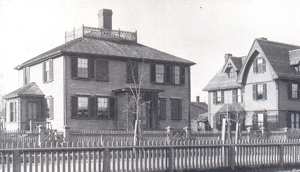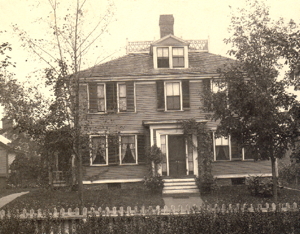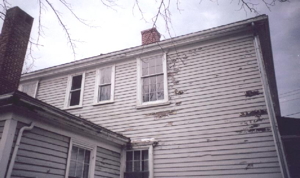The 1870's - The Beginning of Many Changes to the Edmund Fowle House
An extensive study of the building fabric by Architectural Conservator Andy Ladygo was completed in March, 2006. The original layout of the second floor has been uncovered after being hidden for over 125 years.
Plans for the restoration and renovation of the house, both inside and out, are being finalized by the Building Restoration Committee and the Massachusetts Historical Commission. The general construction plans will go out for bid thereafter and work on the house will start in early summer, 2006.
For years, this house was known as the Marshall Fowle House. Marshall Spring Fowle (1788-1855) was the son of Edmund and was named for the respected local physician, Dr. Marshall Spring (1741-1818), who treated men wounded at the Battles of Lexington and Concord. Marshall Fowle was the last of the Fowles to own the house. He lived in it his whole life. It has been written that he was married in his own parlor and that he never slept anywhere else. When he died in 1855, the house was left to his sister, Rebecca Bradlee. She sold the house and land to William, Charles and Jeremiah Russell, who owned many parcels of land in Waterotwn around this time. They, in turn, sold the house and land to Sturgis and Brigham, Architects, in 1871.
John Sturgis and Watertown architect Charles Brigham were partners and designed many well-known buildings, including the original Museum of Fine Arts in Boston's Copley Square and the Church of the Advent on Beacon Hill. When Sturgis died in 1888, Brigham went on to design the extension to the State House in Boston, the addition to the State House in Augusta, Maine, the Christian Science Mother Church in Boston and many other buildings. Brigham lived on Garfield Street in Watertown and designed many of the houses on that road. His house, as well as the studio he built for his wife and the house he built for his groundskeeper, still stand to this day.
In 1871, Sturgis and Brigham moved the Fowle House from Mt. Auburn Street to its present location and began to modernize it. A short article in the Watertown Press from June 28, 1872, reads "The old Marshall Fowle House, of hallowed memory...has been moved to the rear of its old site. It passed from the heirs of the Marshall Fowle estate, to Mr. Wm. Russell, and was recently sold to Sturgis & Brigham, architects. The house is in the process of re-modeling. A street will be run directly front of it from Spring to Mt. Auburn streets, and the broad fields which have surrounded it will be cut up into house lots. Rumor says that ancient coins were found in the old cellar."
The base of the enormous center chimney, which was used to vent several fireplaces, could not be moved with the dwelling. Only the chimney section above the second floor, including the section above the roof, is original. The house would now be heated by stoves, as is evident from the many round cutouts in the floors and walls to accommodate stovepipes.
Another article from the Watertown Press, dated July 26, 1872, reads: "The old Marshall Fowle estate, now owned by Sturgis and Brigham, architects, is being rapidly improved. The cellar of the old homestead has been filled up, and six lots of land have already been sold, with the erection of first class dwelling houses upon them immediately in prospect." This section of Watertown was quickly losing its sprawling fields and becoming populated with many new "Victorian" houses.

The Edmund Fowle House before 1896
(photo courtesy of the Watertown Free Public Library)
The Fowle House was being divided into a 2-family house. An addition was put on the back of the house containing a kitchen for each side. Additional staircases to the attic and cellar were installed. Several changes were also made to the exterior, including the front entryway and the additions of the side porch and entrance, the bay window and the "widow's walk" on the roof. A picket fence was erected around the property. These additions transformed the old colonial dwelling, giving it a more modern look and making it blend in with the other houses being built on the newly laid out Marshall Street.
Because building permits were not required (or, perhaps, not enforced) at this time, we are unsure exactly when certain changes or additions were made.
We know the picture above was taken before 1896, because we have a copy of an essay that was read before the Historical Society in May, 1896, that mentions the Fowle House's roof dormer. There is no dormer in the picture above, whereas a picture of the house that was found in a publication from 1900 clearly shows the dormer. At some point, a hallway with a window was added on the second floor between the two windows on the southeast side of the house. This window had not yet been added when the pre-1896 photo was taken.

The Edmund Fowle House circa 1900
A paper written by Marie Gale and published in 2007 by The Handcrafted SoapMaker notes that "by the 1870's, the 'bath-room' was coming into its own; new high-end home designs included a tub, sink and toilet. The porcelain/cast iron clawfoot tub is typical of that era. By 1900 nearly all new homes had indoor bathrooms and many older homes were being refitted."
The Historical Society recently obtained a copy of an "Application for Private Sewer and Connection" from the Watertown Department of Public Works dated April, 1893, and signed by Charles Brigham. This may well indicate when the two bathrooms were added on the second floor of the Fowle House. At that time, a window and the dividing wall in the small room on the southwest side of the house were moved to accommodate the additon of two small windows, one for each bathroom. The claw foot bathtubs that were recently removed from the bathrooms have manufacturing dates on the bottom from the 1930s, probably suggesting a possible timeframe for a later update to the bathrooms.
The picture below of the back of the house shows the two bathroom windows and the larger window to the right that was moved to open up space for the addition of the bathrooms. The large window is clearly no longer aligned with the window on the first floor. This window will be returned to its original location as part of the planned renovation.

View of the Edmund Fowle House showing the back windows
